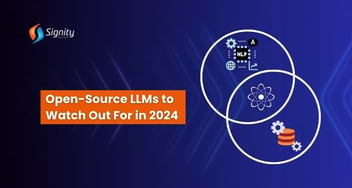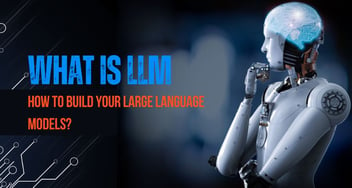How to Train LLM on Your Own Data: A Step-by-Step Guide
Using your own data to train an LLM guarantees that it comprehends business requirements and industry-specific terminology. From model selection and data preparation to fine-tuning and deployment, this tutorial covers all the important phases. It also tackles issues like data privacy and computational expenses.

Large Language Models (LLMs) are crucial for tasks like chatbots, content creation, and complicated problem-solving because they have revolutionized our interactions with artificial intelligence (AI). However, your industry-specific data, jargon, and internal documentation could not always be understood by generic large language models (LLMs). Then what is the right solution?
LLM training on your own data records is the perfect solution.
With robust LLM consulting and development services, you can understand your own dataset and train LLM.
We'll walk you through the training process to optimize an LLM using your own dataset and make sure it meets your business objectives in this comprehensive article.
Key Takeaways
- An LLM will understand your domain-specific terms if it is trained using your unique data, which will improve the precision and applicability of its answers.
- While maintaining the security of sensitive data within your infrastructure, a well-tuned LLM supports your business goals.
- Depending on your data and resource limitations, fine-tuning and Retrieval-Augmented Generation (RAG) aid in optimizing model performance.
- Over time, post-deployment monitoring, user feedback, and recurring retraining improve the LLM's precision and flexibility.
Why Train an LLM on Your Data?
By using your unique data to train an LLM, you can make sure the model has knowledge of industry-specific jargon, which will increase the precision and applicability of its answers. Deep customization is possible, allowing for tailored consumer encounters that complement the goals and voice of your business.
The reports have stated that the global LLM market is projected to reach $259.82 billion by 2030.
It also improves data security by lowering the risks associated with third-party AI models by retaining proprietary and sensitive data inside your infrastructure. You can obtain a competitive advantage with a more intelligent and effective AI solution by customizing the LLM to your company's requirements.
Related read: How to Make Your Product AI-Driven With LLM? Check out the blog.
Steps to Train Your LLM
To tailor your LLM to your unique requirements, organized model training is a necessary part of the training process. Over time, you can improve accuracy, relevance, and performance by using the same data consistently. The actions consist of:
Step 1: Define Your Goals and Use Case
Prior to starting model training, it is essential to create a clear plan by defining your objectives. A well-defined goal ensures that the training process satisfies the needs of your business and yields the intended outcomes.
- What particular problem are you trying to solve?
- Which dataset will be utilized for training?
- To what extent does the model need to be customized?
Training an LLM to comprehend medical terminology, patient records, and confidential data, for instance, can be your objective if you work in the healthcare industry.

Step 2: Select the Right LLM
Selecting the right large language model (LLM) depends on your specific task, computational resources, and training data availability. While pre-trained models offer a quick start, a custom model with fine-tuning on your dataset ensures better accuracy.
The right model architecture optimizes resource utilization and enhances response quality in the LLM training process. Some options include:
- OpenAI’s GPT Models: Suitable for API-based customization.
- Meta’s LLaMA: Open-source and adaptable.
- Google’s PaLM: Optimized for large-scale training.
- Mistral, Falcon, or BLOOM: Open-source options for on-premises deployment.
If you need a lightweight model, consider smaller models like GPT-3.5, Falcon-7B, or LLaMA 2-7B.
Step 3: Gather and Prepare Your Data
Given that it has a direct effect on the model's performance, high-quality training data is crucial for optimizing an LLM. Accuracy is increased and the model is better able to produce language that is human-like when a varied, well-structured training dataset is obtained from trustworthy data sources. To gather and prepare your dataset, take the following actions:
Identify Data Sources: Extract real-world data from diverse sources such as internal documents, customer interactions, knowledge bases, product manuals, and structured databases.
Preprocess Data:
- Remove unnecessary characters, duplicate entries, and irrelevant data.
- Convert files into a machine-readable format (e.g., JSON, CSV, or text data files).
- Tokenize sequential data using byte pair encoding (BPE) for better model efficiency.
Ensure Data Quality: Perform a deduplication process and label datasets properly to prevent biases and enhance response quality.
Step 4: Choose a Training Approach
You can train models using two common approaches:
1. Fine-Tuning
Fine-tuning means taking a pre-trained model and adapting it to your custom data. It requires computational resources but significantly enhances model performance. Use libraries like Hugging Face’s Transformers for this.
Steps for Fine-Tuning:- Load a pre-trained model (e.g., GPT-3, LLaMA 2, or Falcon).
- Format the dataset into input-output pairs (prompt-response pairs).
- Use PyTorch or TensorFlow for instruction fine-tuning.
- Train the model on GPUs (e.g., NVIDIA A100, H100) or TPUs.
2. Retrieval-Augmented Generation (RAG)
Instead of model retraining, you can use Retrieval-Augmented Generation (RAG), where the LLM retrieves information from a database in real-time.
- RAG works best for dynamically updated knowledge bases.
- It is computationally cheaper than extensive training.
- Popular tools: LangChain, LlamaIndex.
Step 5: Select the Right Training Infrastructure
Large models demand a lot of processing power. Select one of the following choices based on your needs:
- Cloud-Based: For extensive training, scalable GPU instances are provided by AWS, Google Cloud TPU, and Azure ML.
- On-Premises: Use on-premises GPU clusters (such as NVIDIA DGX systems) for sensitive data.
- Hybrid Approaches: For best results, combine on-premises and cloud configurations.
Step 6: Train and Evaluate the Model
Start the training process to create your own large language model (LLM) as soon as your computational resources and training data are available.
- Choose Model Architecture: For best results, balance model parameters and resource usage when choosing a transformer model for your particular activity.
- Hyperparameter Tuning: To optimize the model's performance and enhance response quality, change the batch size, learning rate, and model weights.
- Training: To effectively train models using large-scale training methods, use frameworks like Hugging Face, PyTorch, or OpenAI's fine-tuning API.
- Validation: To make sure the model can produce language that is human-like, assess using a training dataset and compare outcomes with actual data.
- Evaluation Metrics:
-
- Perplexity: Better fluency in text data is indicated by lower numbers.
- Text similarity is measured against input-output pairs using BLEU/ROUGE scores.
- Human Feedback: Gather information about the caliber of responses to improve model performance.
Iterate through model retraining to enhance accuracy and mitigate bias and ethical considerations.
Step 7: Deploy the Fine-Tuned Model
Once training is over, use your personalized model for practical uses. Depending on your requirements, selecting the best deployment technique guarantees optimum performance, scalability, and effective resource use.
APIs: Easily integrate your refined model with a variety of apps by using an API with FastAPI, Flask, or LangChain.
Edge Deployment: Reduce reliance on computing resources and ensure real-time processing for applications that are sensitive to latency by optimizing for local execution on devices.
Cloud Hosting: Make use of scalable infrastructure and extensive training capabilities by deploying on cloud platforms such as AWS Lambda, Google Vertex AI, or Azure Machine Learning.
After deployment, track the model's performance and retrain it on your own data on a regular basis to enhance response quality and adjust to changing needs.
Challenges and How to Overcome Them
Large language model (LLM) training presents a number of challenges, such as potential biases, high processing costs, and data privacy issues. It is possible to guarantee successful model development and ideal model performance by being aware of these challenges and putting good techniques into practice.
1. Data Privacy Concerns
Maintaining data privacy during LLM training requires protecting sensitive data. Data records are protected by encryption, and infrastructure is kept safe using federated learning, which allows model training without disclosing raw data.
2. High Computational Costs
Large language model (LLM) training is expensive due to the substantial computational resources needed. While cloud-based AI accelerators boost resource consumption for large-scale training, methods such as low-rank adaptation (LoRA) increase the efficiency of fine-tuning.
3. Bias and Ethical Considerations
To ensure fairness and mitigate bias in training, LLMS needs training data from a variety of sources. By preventing skewed outputs and boosting response quality, bias-detection systems improve the model's performance in practical applications.
Train Your Large Language Models With Our Consultants
It takes knowledge of model architecture, fine-tuning, training data preparation, and computational resources to train your own large language models (LLMs). At Signity Software Solutions, our advisors will help you at every stage, from choosing the best transformer model to fine-tuning hyperparameters for peak performance.
Train LLM on Your Own Data for Precise and Relevant Results
Partner with Signity to develop a customized AI solution tailored to your business needs
To make sure your LLM training process is effective and economical, we will assist you in managing data protection, bias reduction, and resource utilization. Our professionals help with training, assessing, and implementing a model that meets your objectives, whether you're working with pre-trained models, real-world datasets, or bespoke data. Join hands with us to develop an AI system that produces writing that is human-like in quality and integrates seamlessly.
Frequently Asked Questions
Have a question in mind? We are here to answer. If you don’t see your question here, drop us a line at our contact page.
What are the key steps to training an LLM on my own data?
![]()
Determining your goals, using a pre-trained model or starting from scratch, collecting and preparing training data, optimizing the model, assessing its performance, and implementing it for practical uses are all steps in training an LLM on custom data.
What kind of data can be used for training an LLM?
![]()
Both structured and unstructured data can be used, such as text data from emails, papers, chat logs, or real-world data like encounters with customers. Prior to training, make sure the dataset is clean and free of inconsistencies.
How much computational power is required to train an LLM?
![]()
The size of the model and the difficulty of training determine the computational resources. GPUs can be used for small-scale fine-tuning, while TPUs or cloud-based AI accelerators like AWS, Google Cloud, or Azure might be needed for large-scale training.
How do I evaluate the performance of my trained LLM?
![]()
Can I train an LLM without sharing my private data?
![]()
Yes, you can train the model across several devices using federated learning without disclosing private information. On-premise training and data encryption also aid in protecting data privacy while optimizing your model.













